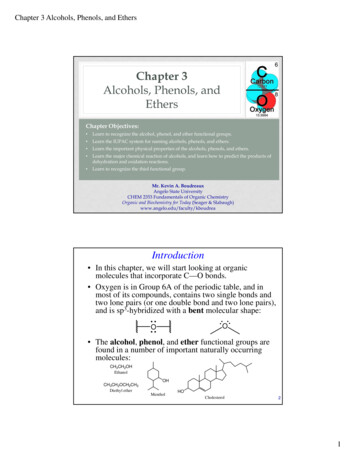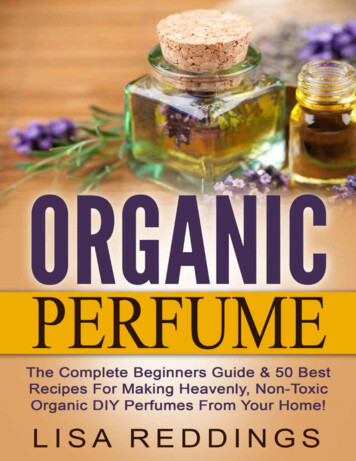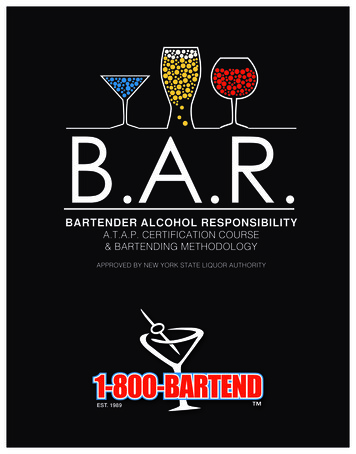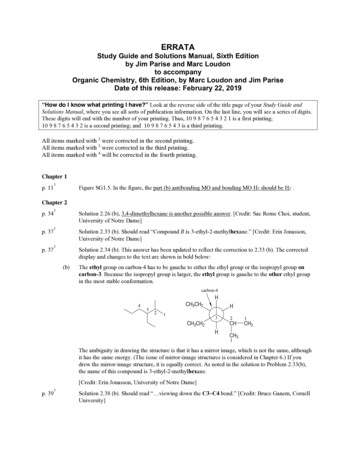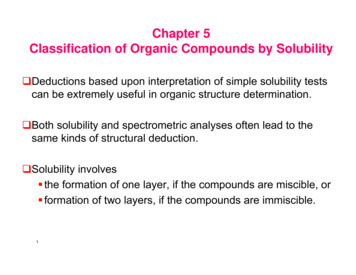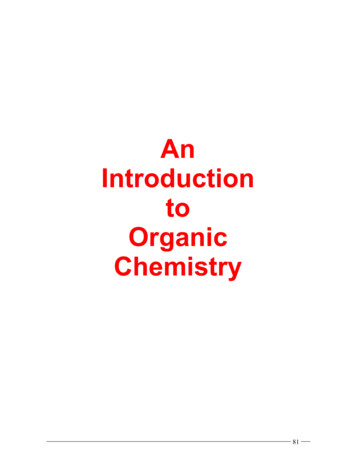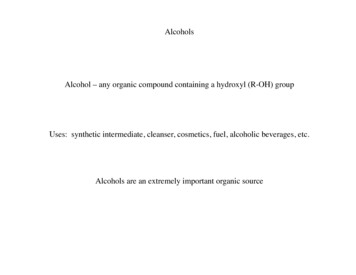
Transcription
AlcoholsAlcohol – any organic compound containing a hydroxyl (R-OH) groupUses: synthetic intermediate, cleanser, cosmetics, fuel, alcoholic beverages, etc.Alcohols are an extremely important organic source
NomenclatureFor an alcohol the longest continuous chain containing the hydroxy groupdetermines the root name and then an –ol is used as the suffixCH3CH2OHEthanolIn numbering the chain, the hydroxy group takes priority to find the lowest numberCH3CHOHCH2CH32-Butanol
Priority in NumberingOf substituents learned so far, alcohol has the highest priorityOH4-bromo-2-cyclohexen-1-olBrAlkenes have higher priority than halides or alkyl substituents3-bromocyclohexeneBrWith only halides or alkyl substituents, the lowest number goes to the first substituent1-bromocyclohexane(1 is not required)Br
All other nomenclature is identical to that previously learnedThere are common names, however, with an aromatic ringBenzene(also called a phenyl group)OHPhenol(takes phenyl root with –ol suffix)
Physical PropertiesThere are two physical properties of alcohols that account for their behavior:molecular dipole and hydrogen bonding abilityDipoleThe electronegative oxygen causes the molecule to have a dipole momentThis high dipole-dipole interaction causes alcohols to have a higher affinity for stateswhere the dipoles can be aligned (therefore boiling point is higher)
Dipole-dipole interactions, however, are much weaker than hydrogen bonding interactionsA hydrogen bond is an interaction between a weakly acidic hydrogenand a lone pair of electrons on a different atomEach hydrogen bond has an energy of 4-5 Kcal/molThis is much smaller than a covalent bond (O-H 104 Kcal/mol) but a compound can havemultiple hydrogen bonds that need to be broken to “escape” the liquid phase(i.e. causes a higher boiling point)
Due to this hydrogen bonding ability of alcoholsthey are both hydrophilic and hydrophobicHydrophilic – “water loving”Hydrophobic – “water hating”Due to this property alcohols have a high water miscibilityuntil the carbon chain becomes larger
Methanol versus Ethanol BiochemicallyEthanol (which is known to lower inhibitions and cause a lightheadedness)is oxidized biochemically to enaseOHOOHThe physiological side effects of consuming ethanol are due to the buildup of acetaldehyde(causes nausea, dizziness, seating, headaches, lower blood pressure)The acetaldehyde is then oxidized biochemically to acetic acidSome people have a nonfunctioning aldehyde dehydrogenase enzyme-these people experience the side effects of acetaldehyde with low ethanol consumption
Methanol also gets oxidized by the same enzymeOHalcoholdehydrogenaseOHHBut due to one less carbon, this oxidation creates formaldehyde not acetaldehydeFormaldehyde is toxic to the body because it disrupts other essential enzymesform working properlyEthanol is consumed 25 times faster than methanol by this enzyme
Acidity of AlcoholsThe alcohol O-H bond is weakly acidicWe have already seen the use of alkoxides in substitution reactionsCH3ONasodium methoxideThe alkoxides can be generated by reaction of an alcohol with sodium hydride
The acidity of an alcohol changes depending upon substitutionExtending the alkyl chain raises the pKaCH3OHCH3CH2OHpKa15.515.9Also increasing the branching increases the pKa(CH3)2CHOH(CH3)3COHpKa17.118.0Both effects due to electron donating ability of methyl groups(inductive effect)
Placing an electron withdrawing group on alcohol will lower the H2OHpKa15.914.312.414.615.4Also an inductive effect, the electronegative atom will inductivelypull electron density away from alkoxide in the deprotonated form
Phenol is more acidic relative to other alcoholspKa 10Greater acidity is due to the resonance forms of the phenolatethat stabilize the negative charge
Synthesis of AlcoholsWe have already learned numerous ways to synthesize an alcoholHBrHNaOHHHOHH1) Hg(OAc)2H2O, H HOH1) BH3 THF2) H2O2, NaOHHOOH2) NaBH4KMnO4, NaOHor OsO4, H2O2HOOHRCO3H, H2OHOOH
Another route to alcohols is an addition to a carbonyl groupCarbonyl carbons can act as an electrophilic site
Addition to carbonyl creates an alkoxideOONUCNUCWork-up in acidic medium will therefore protonate alkoxide to create an alcoholONUCOHH NUC
How doe we create carbon-based nucleophiles?We need to create a polarized bond between carbon and another atomThere are two convenient ways to generate these carbon based nucleophiles1) Grignard ReagentsIodine is most reactive followed by bromine then chlorine(fluorine is relatively nonreactive towards Grignards)Bond is polarizedacts like R- MgBr
If a Grignard reagent reacts with a carbonyl then an alcohol is produced
Second way to create a polarized bond is to use an organolithium compoundR2 LiIRLiILi2 LiCH3CH2LiCH3CH2BrOCH3CH2LiHHCH3CH2CH2OH CH3CH2CH2OH
Using Grignard Reagents (or Organolithiums) to Create AlcoholsAlready saw how reaction with formaldehyde will create a 1 alcoholthat has one additional carbon than starting material
If reaction is between Grignard reagent and an aldehyde a 2 alcohol is obtained
A 2 alcohol can thus potentially be prepared in two ways using a Grignard reagentThe aldehyde can be used on either “halve” of the retrosynthetic analysisOOHMgBrOHHOHCH3MgBr
Additionally, if Grignard reagent is reacted with a ketone a 3 alcohol is obtained
Acid Chloride and EstersIf a carboxylic acid group is modified a Grignard reagent can react(carboxylic acids will not react due to acid-base considerations)All three carbonyl derivatives can be interconverted(will be covered in later chapter)
Addition of one equivalent of Grignard reagent to an acid chloride (or ester)creates a tetrahedral alkoxide with a good leaving groupThe chloride will leave in a subsequent step to regenerate the carbonyl groupThe ketone will react again with the Grignard reagent to create a 3 alcohol
Grignard reagents will also react with epoxidesORO H!RMgBrThe Grignard reacts in a SN2 mannertherefore will react at least hindered carbon with inversion of configurationGenerates an alcohol which is two carbons removed from Grignard addition
Besides being good nucleophiles,Grignard reagents and organolithiums are STRONG basesCarbon based anions (without resonance stabilization) have pKa values 50Remember that carboxylic acids have pKa of 4 and alcohols 16Follow directly from electronegativity trend
Due to this high basicity,Grignard reagents CANNOT be used with even weakly acidic compoundsEquilibirum is driven by acid-base reactionTherefore NO alcohols or amines (or any labile hydrogens)can be present anywhere in the molecule for a Grignard reaction
Another Problem: Grignard reagents are NOT selectiveGrignard reagents are strong nucleophiles so they will react with any electrophilic double bond(reactivity versus selectivity)This is good to react with carbonyl groups,but if any other reactive groups are present they will also reactWill react with various multiple bond structuresCannot react at one site preferentially if more than one reactive site is present
One effect of these side reactions:Grignard reagents can be used to reduce alkyl halides to alkanesIf an acidic hydrogen source is present an alkane is generatedTherefore this represents a reduction of the alkyl halide
Another way to reduce alkyl halides is to use Lithium Aluminum HydrideCan consider LAH as a source of hydride (H: -) anionsIf LAH is reacted with an alkyl halide an alkane is formed
LAH can also be used to create alcoholsThe hydride anion can react as a nucleophile with an electrophilic carbonyl groupTherefore a ketone upon reaction with LAH creates a 2 alcohol
Likewise an aldehyde is reduced to a 1 alcohol with LAHIn essence these reductions are adding hydrogen to both ends of the carbonyl bond,both the carbon and oxygen of the original double bond are bonded to a new hydrogen
Sodium Borohydride will also reduce a ketone and aldehydeto a 2 and 1 alcohol, respectivelySince both boron and aluminum are in the same column of the periodic tablethey share similar chemical properties
The reactivity increases down the periodic tableTherefore aluminum is more reactive than boron(LAH is more reactive than NaBH4)Due to this increased reactivity LAH will not work in alcoholic or aqueous solvents– it reacts with the solvent before reducing the carbonyl groupTherefore need to work-up LAH reactions in a SECOND stepThis is not true with NaBH4these reactions CAN occur in alcoholic solvents
Due to the increased reactivity,LAH can reduce other carbonyl functional groups that NaBH4 cannot
Sodium Borohydride (NaBH4) is thus more selective than LAH
ThiolsSimilar to the chemistry of alcohols(sulfur is in the same column as oxygen)NomenclatureFollow the same rules as learned for alcohols but use –thiol suffix instead of -olCH3OHCH3SHmethanolmethanethiol
Differences between alcohols and thiolsThiols are stronger acidsdue to charge being placed on more polarizable sulfur and a weaker S-H bondThiols have less hydrogen bonding than alcoholsdue to sulfur being less electronegative than oxygen
Thiolate anions are more nucleophilic than alkoxide anionsDue to the more polarizable sulfur, and bigger atom which results in less solvationin protic solvents, the thiolate is more nucleophilic than an oxygen anionThis increased nucleophilicity allows the formation of sulfonium saltsSame reaction does not occur readily with ethers
Sulfonium salts are used as alkylating agentsSimilar to SN2 reactions observed with methyl halides
These sulfonium salts are used as methylating agents biologicallyMethyl iodide cannot be used in living cells–low water solubility and too reactive (will react nonselectively with amines)Common methylating agent in living cells is S-Adenosyl methionine (SAM)
One example:Conversion of norepinephrine to epinephrine
Thiols can be oxidized to form a disulfide bondThis process is used in proteins to link together cysteine amino acidsThe disulfide bond thus can lock the protein in a particular shape
The formation of the disulfide bridge can change the properties of the protein
A cosmetic application of disulfide bridgesHuman hair consists of a protein (keratin) that contains a large percentage of cysteine( 4 times the amount found in other proteins)The cysteine forms disulfide bonds to keep the hair in a particular shapeTo change the shape:A reducing agent is applied which breaks the disulfide bondsThe hair is then rearranged into a desired shape (curlers or combing)An oxidizer is added to maintain the new shape of the hairTo change straight hair to curly this is called a “permanent”To change curly hair to straight this is called a “hair straightening”
Stronger oxidation of thiols generates sulfonic acidsWith mild oxidation the thiol can be converted to a disulfide,stronger oxidation however oxidizes the sulfur to a sulfonic acidTypically use potassium permanganate or nitric acid for this oxidation(use strong conditions, usually heat)
Alcohols! Alcohol – any organic compound containing a hydroxyl (R-OH) group! Uses: synthetic intermedia
